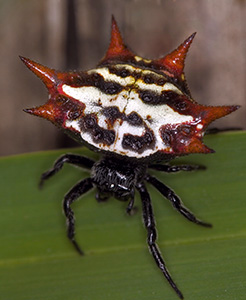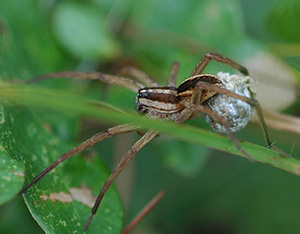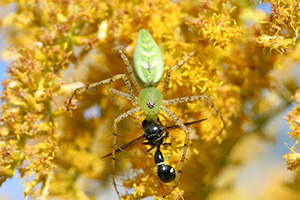Florida Spiders: Arachnids in the Garden
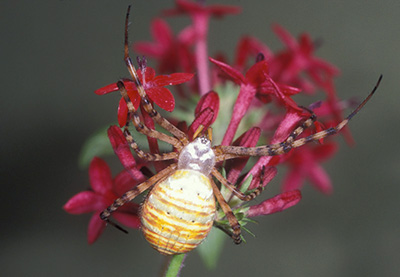
Photo: Paul Choate, University of Florida
While gardening, you might encounter a whole manner of critters, including the eight-legged variety. Florida’s spiders are both interesting and beneficial, preying on pest insects and keeping certain populations from getting too high.
Despite some trepidation from gardeners, these creatures are mostly non-aggressive and shy. Most spiders are venomous as a means to capture and consume prey, but only a few in Florida have venom that is strong enough to cause humans to seek medical attention.
It’s important to understand the differences between the species and how to identify them. Below is a list of spiders commonly encountered in the Florida garden.
Family Araneidae
Garden orb weavers (Argiope spp.) — In Florida, there are four different species of Argiope: yellow garden orb weavers (Argiope aurantica), banded orb weavers (A. trifasciata), silver orb weavers (A. argentata) and Florida garden spiders (A. florida). The females of this genus will surely catch your eye, as they are among the largest of the web-building spiders. Argiope spiders are also known for the zigzag pattern they build into their webs, an object of continual debate among scientists as to why they do this. These striking spiders are no threat to humans and even serve as pest control by consuming insects that are damaging to gardens.
Spiny-backed orb weaver (Gasteracantha cancriformis) — As the name suggests, the spiny-backed orb weaver has colorful spines protruding from its crab-shaped abdomen. The spiders range in color, from white with red spines, to yellow with black spines. They help keep mosquito populations in check by catching them in their circular webs that resemble a wheel. There are no known serious effects to humans if bitten.
Golden silk orb weaver (Trichonephila clavipes) — Commonly known as the banana spider in Florida, the golden silk orb weaver is one of the largest spiders in North America. The females range in size from 24 to 40 mm, with distinguishing yellow spots on a dull orange to tan cylindrical body, with brown and orange banded legs. The males are tiny (around 6mm) and inconspicuous with a brown hue, and can often be seen found sitting in a female banana spider’s web. Other web occupants looking for a free meal include the kleptoparasitic dewdrop spider, which feeds on leftover prey. The banana spider likes to weave its web of golden silk in open woods or edges of dense forest, usually attached to trees or low shrubs. They can also be found in the home landscape, but fear not — these large creatures only bite if squeezed, and the effects are localized and clear up quickly.
Family Lycosidae
Wolf spiders — Named for their hairy appearance, wolf spiders are not web builders; they in fact charge at their prey and are quite fast runners. But don’t worry, these hairy creatures will not run towards humans! The Lycosidae family includes hundreds of species. They come in a range of brown to tan colors with at least one row of black stripes from the eyes to the abdomen. The males tend to be lighter in color than the females, but otherwise they look quite similar. Wolf spiders are known for providing maternal care to their young; the female will carry the egg sac behind her, and when the spiderlings hatch, they will cling to her back until they are big enough to hunt on their own. Wolf spiders are found in open wooded areas, shrubs, leaf litter and herbaceous vegetation. Some dig burrows or hide under debris. They can also be found in the home or garage. Their venom is not dangerous to humans.
Family Oxyopidae
Green lynx spider (Peucetia viridis) — The green lynx spider can surprise its prey by blending into its environment, but most of the time it’s bright green. It is not a web builder; instead, it will sit on vegetation and wait for an insect to approach. This sneaky spider will aggressively attack prey species, but very rarely will bite humans (and these bites are of little concern). The green lynx spider mainly feeds on insects that dwell in shrubs or herbaceous vegetation. It is also known to be a predator of crop-damaging insects, so can be a welcome resident in the garden. With that being said, because it is a generalist predator, it does occasionally consume insect pollinators.
Family Theridiiae
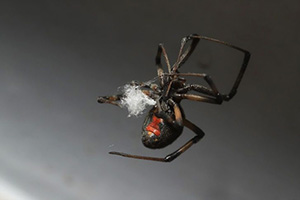
Widow spiders (Latrodectus spp.) — Florida’s widow spiders include the southern black widow (Lactrodectus mactans), the brown widow (L. geometricus), the northern black widow (L. variolus) and the red widow (L. bishopi). These spiders weave messy cobwebs often found in branches of shrubs and among human-made structures such as in the corners of buildings or entryways, under lawn furniture, under eaves, within stacked equipment, in crevices of outdoor trashcans, and inside cluttered storage closets and garages.
The egg cases of widow spiders are attached to the cobweb, are teardrop in shape and wrapped in silk. Widow spiders have a bulbous abdomen. On the underneath side of the abdomen, they have a characteristic red or orange hourglass shape. The brightly colored marking and the egg cases are useful for identifying which spider may have caused a bite. If you suspect being bitten by a widow spider, seek medical care, as their venom is significant for humans. But usually, these spiders will retreat when disturbed. Bites sometimes occur if the spider is grabbed, such as when picking up a flowerpot or the handle of a trash can. They can also bite if they get lodged inside clothing or if people stick their hands into dark corners.
Spiders are out there in the garden, whether you can see them or not. For fun, you can take a flashlight out at night and shine it on the ground around your garden. You will see your natural pest control at work as the jewel-like eyes of the spiders reflect in beautiful colors.
The unique characteristics of spiders make them interesting garden critters with which to coexist. Not only are spiders beneficial to us in the landscape with services such as pest control, but hummingbirds use their webbing to construct nests. For help identifying a spider, contact an agent at your county UF/IFAS Extension office.
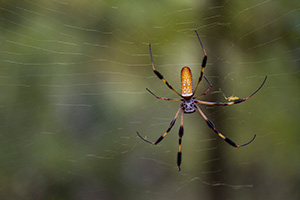
Also on Gardening Solutions
More from UF/IFAS
- An Introduction to Some Common and Charismatic Florida Spiders
- Brown Widow Spiders–UF/IFAS Extension Sarasota County
- Golden Silk Spider, Trichonephila clavipes
- Green Lynx Spider, Peucetia viridans
- Southern Black Widow Latrodectus mactans
- Spiny Orb Weaver Spider, Gasteracantha cancriformis
- Weekly “What is it?” Wolf Spiders–UF/IFAS Blogs Escambia County
- Yellow Garden Spider, Argiope aurantia

